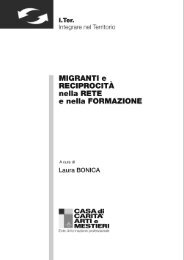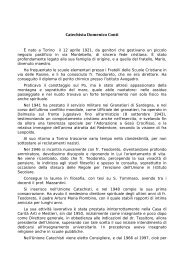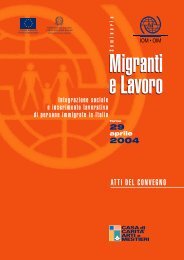Rapporto finale/ Final Report (ITA-ENG) - Casa di Carità Arti e Mestieri
Rapporto finale/ Final Report (ITA-ENG) - Casa di Carità Arti e Mestieri
Rapporto finale/ Final Report (ITA-ENG) - Casa di Carità Arti e Mestieri
You also want an ePaper? Increase the reach of your titles
YUMPU automatically turns print PDFs into web optimized ePapers that Google loves.
55<br />
In all of the countries involved, one point that emerged clearly right from the start was that educational<br />
environments are the places under the greatest pressure to continuously address the most<br />
complex concerns arising from an unprecedented scenario of pluralism and globalisation. Combating<br />
inequality, protecting fundamental rights, fostering <strong>di</strong>alogue between <strong>di</strong>fferent cultures, supporting<br />
adolescents in the process of identity buil<strong>di</strong>ng are, in actual fact, much more complex to manage<br />
within schools and vocational training centres than elsewhere. In this scenario, teachers and learners<br />
from the various countries involved reported that <strong>di</strong>scrimination is frequently part of everyday life in<br />
relations between groups of youths.<br />
Racial and religious <strong>di</strong>scrimination is not only an issue between foreigners and natives, but also between<br />
<strong>di</strong>fferent groups of foreigners. The Roma are still one of the most <strong>di</strong>scriminated against ethnic<br />
groups: since it is <strong>di</strong>fficult to have any contact with these groups, most people know practically nothing<br />
about them and so they generate fear and anxiety in young people.<br />
However, race is not the only issue: in the majority of schools the <strong>di</strong>sabled and homosexuals are<br />
exposed to <strong>di</strong>scrimination. Social, demographic and economic con<strong>di</strong>tions are also causes of intolerance<br />
in schools. One example is <strong>di</strong>scrimination based on where one lives. In France, for instance, this<br />
generates marginalisation of students who live in the suburbs. In schools, the formation of groups was<br />
frequently found to be based on such characteristics.<br />
Gender-based <strong>di</strong>scrimination persists in many places, as do stereotypes of the role of women in society<br />
and the family, which frequently emerge in <strong>di</strong>scussions at school and in games and jokes among<br />
pupils. Muslim women who wear a veil are in some ways the most <strong>di</strong>scriminated against, in that they<br />
are subject to both religious and gender-based <strong>di</strong>scrimination.<br />
In some local contexts widespread intolerance was reported towards people generally regarded as<br />
“unfortunate” (even just because of how they dress or speak), people who are <strong>di</strong>fferent from the<br />
crowd and so are <strong>di</strong>scriminated against.<br />
The persistence of <strong>di</strong>scrimination linked to institutional decisions and thus in some way determined<br />
by a position taken by the state, is of particular concern. One example that emerged in France is the<br />
presence of EREAs, separate education establishments for children with learning problems. These<br />
tend to brand people as irredeemably <strong>di</strong>fferent and pupils in these classes find it really <strong>di</strong>fficult to fit in<br />
at school. Generally speaking, in France the fact that the institutions refuse to acknowledge the existence<br />
of <strong>di</strong>scrimination and intolerance in schools makes any work on these issues extremely <strong>di</strong>fficult,<br />
despite the fact that teachers and pupils are increasingly aware of how <strong>di</strong>scrimination affects everyday<br />
life in the classroom and recognise the need to address the matter openly. Leaving the specific<br />
case of France aside, institutions can negatively affect integration even “simply” by not allocating the<br />
necessary time or resources to the issue. This is an aspect that is becoming more widespread in an<br />
overall climate of crisis and shortage of funds for education.<br />
The forms of <strong>di</strong>scrimination described above are examples of “the strong prevailing over the weak”<br />
who may be vulnerable owing to the fact that they are foreigners, <strong>di</strong>sabled, of a <strong>di</strong>fferent sexual orientation<br />
or somehow just <strong>di</strong>fferent from the crowd. Alongside such manifestations of intolerance and<br />
racism, there are also forms of latent racism expressed implicitly under the guise of attitudes that are<br />
socially more acceptable. This subtle, latent racism does not usually lead to outright hostility. It does,







